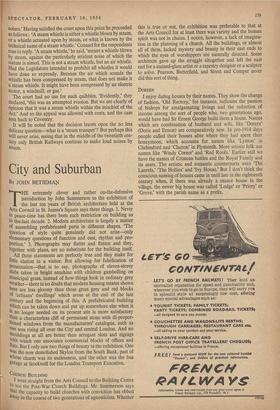City and Suburban
BY JOHNBETJEMAN THE extremely clever and rather on-the-defensive introduction by John Summerson to the exhibition of the last ten years of British architecture held at the Arts Council in St. James's Square says three things. 1. Never in peace-time has there been such restriction on building as in the last decade. 2. Modern architecture is largely a matter of assembling prefabricated parts in different shapes. 'The question of style quite genuinely did not arise—only elementary questions of function and cost, rhythm and pro- Portion.' 3. Photographs may flatter and flatten and they, together with plans, are no substitute for the building itself.
All these statements are perfectly true and they make for little elation in a visitor. But allowing for falsification of presentation—that is to say, photographs of eleven-storey slabs taken in bright sunshine with children gambolling on municipal grass, instead of how things look in ordinary grey weather—there is no doubt that modern housing estates shown here are less gloomy than those great grey and red blocks of 'artisans' dwellings' which arose at the end of the last century and the beginning of this. A prefabricated building Which can be taken down and put up somewhere else when it Is no longer needed on its present site is more satisfactory than a characterless cliff of permanent stone with ill-propor- tioned windows from the manufacturers' catalogue, such as one sees rising all over the City and central London. And no mouldings at all are better than arrogant slots and zigzags nwith which one associates commercial blocks of offices and flats. But I only saw two things of beauty in the exhibition. One Was the now demolished Skylon from the South Bank, part of Whose charm was its uselessness, and the other was the bus garage at Stockwell for the London Transport Executive.
CHURCH BUILDING 1 went straight from the Arts Council to the Building Centre to see the Post-War Church Buildings. Mr. Summerson says that the capacity to build churches with conviction has ebbed away in the course of two generations of agnosticism. Whether this is true or not, the exhibition was preferable to that at the Arts Council for at least there was variety and the human spirit was not in chains. I notice, however, a lack of imagina- tion in the planning of a church. All the buildings, or almost all of them, lacked mystery and beauty in their east ends to which the eyes of worshippers are naturally directed. Some architects gave up the struggle altogether and left the east end for a stained-glass artist or a tapestry designer or a sculptor to solve. Pearson, Butterfield, and Street and Comper never did this sort of thing.
DORERN
I enjoy dating houses by their names. They show the change of fashion. 'Old Rectory,' for instance, indicates the passion of bishops for amalgamating livings and the reduction of income among the sort of people who, two generations ago, would have had Sir Ernest George build them a house. Names which are combination of husband and wife, like `Dorern' (Doris and Ernest) are comparatively new. In pre-1914 days people called their houses after where they had spent their honeymoon, which accounts for names like `Lynton' in Chelmsford and 'Clacton' in Plymouth. More artistic folk use names like 'Windy Corner' and 'Red Roofs.' Earlier still we have the names of Crimean battles and the Royal Family and its seats. The artistic and romantic counterparts were 'The Laurels,' The Hollies' and 'Ivy House.' But 1 don't think the conscious naming of houses came in until late in the eighteenth century when, if there was already a manor house in the village, the newer big house was called 'Lodge' or 'Priory' or 'Grove,' with the parish name as a prefix.


































 Previous page
Previous page